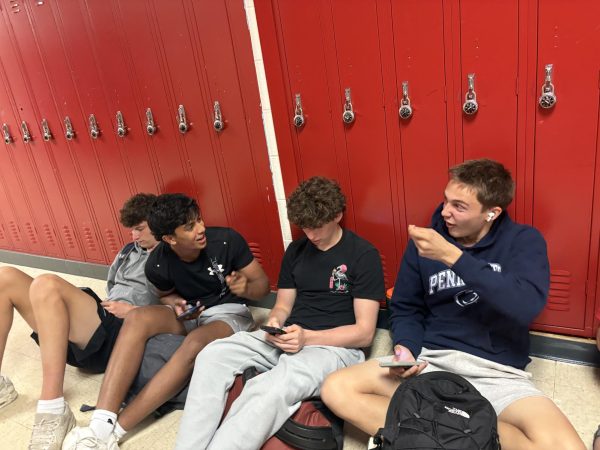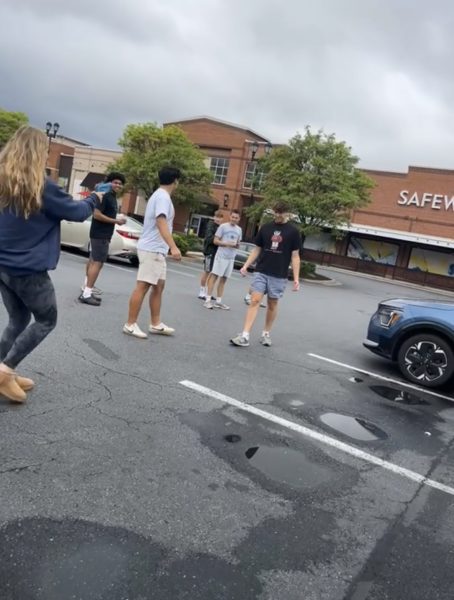The psychology behind trend cycles and marketing to children: Why students should shop sustainably
Photo by Joe Wilcox used with permission from Google Commons
A fallen disposable face mask sits on the grass.
In video essayist Alice Cappelle’s YouTube video “Capitalism and Ego Formation,” Capelle discusses marketing that sells products by essentially telling consumers: “buy the product, buy the lifestyle.”
The branding Cappelle refers to aims to take advantage of peoples’ instinctive desire for a sense of belonging by associating products with exclusive, aspirational lifestyles. Brands that use this strategy will manufacture images and messages centered around desirable qualities that they portray to be inhabited by the product’s consumer base. These qualities differ depending on the brand and product, as branded images are carefully constructed to reflect and cater to the specific interests and ideals of a products’ target audience.
Tech brands often use images that portray their customers as smart and successful, whereas personal care brands use images of cleanliness and beauty. These advertisements may also use the names and images of celebrities or influencers their customers are already familiar with. This adds not only to the aspirational nature of the lifestyle being sold with the product, but also the exclusivity.
Today, in the age of the internet and specifically social media, users are constantly interacting with algorithms that gather personal information about their interests and activity. That information is then compared to that of other users, effectively directing each user toward content specifically catered to them and their tastes. These algorithms are designed to show these users and consumers advertisements related directly to the content they most frequently interact with, increasing consumption and exposure for advertisers.
In other words, the brand determines what its target audience values and uses that information to show them an idealized version of themself or their life, selling them the idea that this fantasy life is achievable and that it is the lived experience of the consumers of this product. Psychoanalyst Dino Felluga describes this image as the “‘Ideal-I’: That fantasy image of oneself that can be filled in by others who we may want to emulate in our adult lives.”
This marketing phenomenon has been particularly harmful to kids and teens in the age of the internet. These ‘Ideal-I’ advertisements have made their way onto platforms such as Instagram and TikTok, platforms that do not always differentiate between content produced by brands and content produced by users, and whose user-bases are made up of majority young people. According to psychologist Susan Linn, EdD, “U.S. companies market to adolescents and children with an annual budget of over $15 billion, or about two and a half times more than was spent in 1992. They now influence over $600 billion worth of spending.”
The need for a sense of belonging is amplified at a young age, especially on social media platforms. APA cites child psychologist Allen Kanner, PhD, who said, “Teens are inundated with so much marketing about the importance of brands to identity and image, it has changed the way they socialize with each other, interact with adults and view themselves and the world.”
The manipulation of children’s psychology for profit, along with the recent dramatic popularity increase in affordable fast fashion brands on Instagram and TikTok, has turned kids and teens into an extremely profitable target demographic.
When kids are always being fed marketing that associates products with creators and lifestyles they look up to on platforms that are constantly adapting to cater to their individual interests, things tend to come and go extremely quickly. Trend cycles have long been recognized as a natural part of consumer culture. Masterclass Style described the process as a cycle “by which a fashion trend is introduced, rises to mainstream popularity, declines, and finally gets rejected in the obsolescence stage.” However, trend cycles have become increasingly rapid on the internet recently, because of the sheer volume of branded content being served to kids when they are scrolling to something new every 15 seconds.
PhD student Mariel Austin described the cycle as it has been up until now. She wrote, “The fashion cycle of a micro-trend is usually 3-5 years, while macro-trends typically last 5-10 years. Macro-trends are the styles we tend to associate with the different decades, for instance, shoulder pads of the eighties, drop-waist dresses in the twenties, and bell-bottom jeans in the seventies.” But because of the incessant exposure of new generations to branded content and advertisements, micro-trends on the internet can go in and out of fashion in as little as a month.
The constantly shortening nature of trend cycles, especially in the case of fast fashion brands, has led to a culture of young consumerism that produces a vast amount of unnecessary environmental waste, as well as sustaining the unethical labor practices that allow fast fashion brands to mass-produce trendy items at such a rapid rate.
As evidence continues to emerge backing the psychological, environmental and ethical harm behind unsustainable consumption, students must recognize their own responsibility and consumption habits. While the systematic conversion of children into consumers is no fault of their own, young people have no chance of overcoming the obstacles created by past generations unless they make conscious decisions to shop sustainably.
Unsustainable industries market using tactics that alter young peoples’ sense of self and the world around them when their minds are at the most vulnerable developmental stages. In doing so, they promote widespread ignorance among consumers who are unknowingly and unwillingly fueling a system that abuses environmental resources and employs unethical labor practices.
Montgomery County and its surrounding area is home to affordable and high-quality secondhand shops and sustainable options. While it’s true that sustainable fashion is not always an option, students here are in a privileged position, and yet continue to feed into systematically oppressive systems of consumption. Entering the new year, students need to reassess their habits as consumers and as people, with the knowledge that they’ve been put at a disadvantage by being born in an age that values consumerism over ethics.
Your donation will support the student journalists of Thomas S. Wootton High School. Your contribution will allow us to purchase equipment and cover our annual website hosting costs.
Senior Isaac Muffett is the opinions editor in his fourth year on the Common Sense staff. When he's not writing or researching, he spends his free time...










